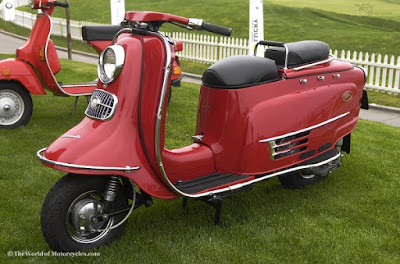Did you ever heard about the Vespa Kongo classic scooters? For those of you the scooter fans from abroad may be feel strange due to have never been heard or known the existence of this classic Vespa scooter type before. But for the Indonesian scooter fans, of course, most of them are already knew and familiar to those Vespa Kongo (or 'Congo' for English spelling) scooters name.
 |
| Vespa Ausburg VGLA/B aka Vespa Kongo is a state award scooter to several groups of the Indonesian Peacekeeping Forces who served in Congo, Central Africa back in the end 1950s to early 1960s. (Picture from: http://bit.ly/2o5cywb) |
Besides having a distinctive shape, it turns out that the antique scooter holds a priceless historical value for Indonesian, and also said has its own prides for those who are lucky able to own it. This Vespa scooter model emerged and gained popularity back in the early of 1960s.
 |
| Several member of the Indonesian Peacekeeping Forces proudly posed with their Vespa Kongo in the 1960s. (Picture from: http://bit.ly/2oED8wa) |
History of the Vespa Kongo name
Actually there are some nicknames that are circulating in Indonesian society about this Vespa scooter model besides the 'Kongo,' including the 'Vespa Telur' (mean 'an egg' in English) because it has oval-shaped side fender like an egg, then there's also called it as 'Vespa Ndog Kentus' which means the same as an egg.
 |
| Several member of the Indonesian Peacekeeping Forces proudly posed with the Vespa Kongo in the 1960s. (Picture from: http://bit.ly/2oGthFZ) |
The designation of the Vespa Kongo itself comes from the name of the country where several groups of the Indonesian National Armed Forces (Tentara Nasional Indonesia/TNI) known as the Indonesian Garuda Contingent (Kontingen Garuda/KONGA) were assigned in the late 1950s and early 1960s. At that time they got the task as the United Nations Peacekeeping Forces from Indonesia in Congo, Central Africa under the mission of the UNOC (United Nation Operations for Congo).
 |
| Vespa Kongo was assembled at the Vespa GmbH Augsburg one of the Vespa factories in Augsburg, Germany. (Picture from: http://bit.ly/2nSPf8T) |
 |
| Front view of the legendary Vespa Kongo of the 1960s. (Picture from: http://bit.ly/2o0ZOGR) |
It was also reported that the Vespa Kongo scooters were distributed based on the military rank, namely for those who had higher rank to get the green colored Vespa 150 cc scooters (Vespa Ausburg T150/4 (type 332, 4-speed) VGLB, while the soldier with lower rank got the Vespa 125 cc (Vespa Ausburg T150/4 (type 332, 3-speed) VGLA in yellow or blue colored.
The Vespa Kongo starting known in the Indonesian scooter market back in the 1963, as a Vespa scooter model belonging to ex-Kontingen Garuda-2 (1960-1961) and Garuda-3 (1962-1963) members, but there is no certain source yet whom said whether the members of the Kontingen Garuda-1 also received the same scooter prizes (due to they assigned to Egypt back in the 1956).
 |
| Vespa Ausburg T150/4 (type 332, 3-speed) VGLA aka Vespa Kongo only exist in Indonesia for the scooter models in between 1960 to 1963. (Picture from: http://bit.ly/2o0ZOGR) |
Kept spur your adrenaline on the power of two-wheeled monster and stay alive with the true safety riding. May God will forgive Your sins and so does the cops......
(This article was deliberately created in order to commemorate the 74th anniversary of the Indonesian National Army (Tentara National Indonesia/TNI) on October 5, 2019.)
Remain as the Guardian of Our beloved Indonesian homeland with all the heart. *** [EKA | FROM VARIOUS SOURCES | KOMPAS | OTOFREAK | MOTOPLUS | OTOMANIA | VESPA]
Note: This blog can be accessed via your smart phone.





































